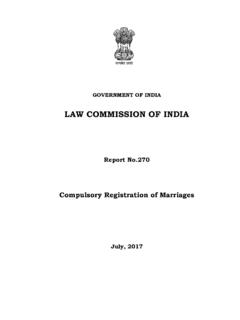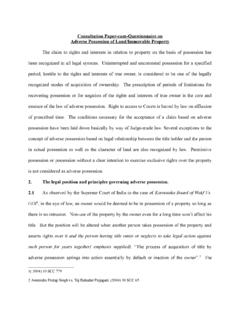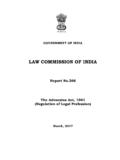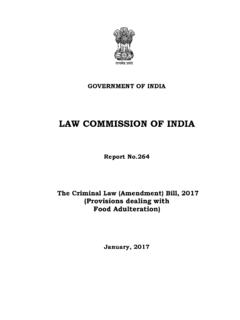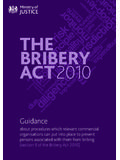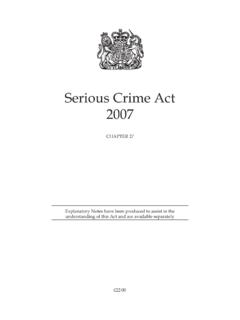Transcription of GOVERNMENT OF INDIA LAW COMMISSION OF …
1 GOVERNMENT OF INDIA LAW COMMISSION OF INDIA Report The prevention of corruption ( amendment ) Bill, 2013 February 2015 ii (3)/274/2015-LC(LS) 12 February, 2015 Dear Mr. Sadananda Gowda ji, As you know, in the meeting taken by Hon ble Finance Minister on 12 November 2014, in pursuance of the informal decision taken by the Cabinet, it was decided to have the views of the Law COMMISSION of INDIA on the issues relating to the proposed amendments to the prevention of corruption ( amendment ) Bill, 2013. Accordingly, on 8 January 2015, the Department of Legal Affairs forwarded the proposal received from Secretary, Department of Personnel and Training, to the Law COMMISSION of INDIA , with a request that a report on the matter may be submitted by the end of February 2015.
2 In view of the short span of time available with us to submit our views, we carried out a study of the United Nations Convention Against corruption (UNCAC) and other relevant statutes and case-laws of INDIA and the , and a draft of the report was given shape. This was further subjected to extensive deliberations, discussions and in-depth study by the COMMISSION and, thus, we have finalised the Report, which is presented with this letter as Report titled The prevention of corruption ( amendment ) Bill, 2013 . With warm regards, Yours sincerely, [Ajit Prakash Shah] Mr. Sadananda Gowda Hon ble Minister for Law and Justice GOVERNMENT of INDIA Shastri Bhawan New Delhi 110115 iii iv Report The prevention of corruption ( amendment ) Bill, 2013 Table of Contents Chapter Title Page I Background to the Report 1-5 A.
3 History of Anti- corruption Law in INDIA 1-2 B. The proposed Amendments to the PC Act, 1988 2-4 C. Mandate of the Present Law COMMISSION 4-5 II Analysis of Section 7 of the 2013 Bill 6-24 A. Section 7: Definitions and Use of Language 6-10 B. Section 7(1) o the 2013 Bill 10-17 C. Section 7(2) of the 2013 Bill 17-24 III Analysis of Section 8 of the 2013 Bill 25-30 A. Sections 8(a) and (b) of the 2013 Bill 25-27 B. Explanation to Section 8 of the 2013 Bill 27-30 IV Analysis of Sections 9 and 10 of the 2013 Bill 31-42 A. Section 9 of the 2013 Bill 31-35 B. Section 10 of the 2013 Bill 35-40 V Analysis of Section 11 of the 2013 Bill 41 VI Analysis of Sections 12 and 15 of the 2013 Bill 42-43 VII Analysis of Section 17A(1) of the 2013 Bill 44-47 VIII Analysis of Sections 18A-I of the 2013 Bill 48-50 1 CHAPTER I BACKGROUND TO THE REPORT A.
4 History of Anti- corruption Law in INDIA Regulation of corruption in some form or the other has a long history in INDIA . The first law broadly dealing with corruption and the attachment of property was a pre-independence, war time ordinance called the Criminal Law ( amendment ) Ordinance, 1944 (Ordinance No. XXXVIII of 1944) (hereinafter 1944 Ordinance ). It was enacted under the GOVERNMENT of INDIA Act, 1935 to prevent the disposal or concealment of property procured by means of certain scheduled offences, including offences under the Indian Penal Code of 1860 (hereinafter IPC ). The ordinance is one of the few remaining permanent ordinances, given that it was enacted when the INDIA and Burma Emergency Provisions were in effect and when, the six month clause requiring ordinances to be statutorily enacted was suspended.
5 It has subsequently been incorporated in the prevention of corruption Act, 1988 (hereinafter PC Act, 1988 ) thus giving the ordinance, the status of law. The first direct and consolidated law on the subject of corruption was the prevention of corruption Act, 1947, which was enacted in independent INDIA to supplement the provisions of the IPC. The existing provisions under the IPC and other laws had proved inadequate to deal with cases of bribery and corruption of public servants, which had increased greatly during the war years, due to scarcity and controls. Therefore, a new law was required to deal with various post-war scenarios, which provided multiple opportunities for corruption these included post-war reconstruction schemes, termination of contracts, and 2 disposal of a large number of GOVERNMENT surplus The 1947 Act sought to incorporate (with modifications) the attachment provisions from the 1944 Ordinance; introduced the offence of criminal misconduct, similar to section 13 of the present 1988 Act; and criminalised attempts to commit certain offences under the Act.
6 However, the scope of the 1947 Act was considered too narrow and the PC Act was enacted in 1988 to replace the 1947 Act and certain provisions in the IPC dealing with corruption . It sought to, inter alia, widen the scope of the definition of public servant; incorporate the offences under sections 161-165A of the IPC; increase the penalties provided; and provide for day to day trial of cases. B. The Proposed Amendments to the PC Act, 1988 The prevention of corruption ( amendment ) Bill, 2013 (hereinafter 2013 Bill ) was introduced in the Rajya Sabha on 19th August 2013 to amend the PC Act, 1988, the Delhi Special Police Establishment Act, 1946 and the 1944 Ordinance.
7 The 2013 Bill was referred to the Standing Committee on Personnel, Public Grievances, Law and Justice on 23rd August 2014, and the Committee submitted its report on 6th February 2014. Subsequently, on 12th November 2014, an informal and improved version of the 2013 Bill was circulated (hereinafter 2014 amendment ) and approved at a Cabinet meeting, based on the recommendations of the Standing Committee. This amended draft was sent to the COMMISSION by way of reference. The Statement of Objects and Reasons to the 2013 Bill makes it clear that the amendments were necessitated by INDIA s ratification of the United Nations Convention Against corruption (hereinafter UNCAC ) in May 2011, judicial 1 Statement of Objects and Reasons of the Bill preceding the enactment of the prevention of corruption Act, 1947.
8 3 pronouncements, and the need to bring domestic laws in line with international practices. It reads as follows: The prevention of corruption Act, 1988 provides for prevention of corruption and for matters connected therewith. The ratification by INDIA of the United Nations Convention Against corruption , the international practice on treatment of the offence of bribery and corruption and judicial pronouncements have necessitated a review of the existing provisions of the Act and the need to amend it so as to fill in gaps in description and coverage of the offence of bribery so as to bring it in line with the current international practice and also to meet more effectively, the country's obligations under the aforesaid Convention.
9 Hence, the present Bill. [Emphasis supplied] However, a perusal of the proposed 2013 amendments makes it clear that the amendments substantially replicate the provisions of the UK Bribery Act 2010 (hereinafter Bribery Act ). This creates certain problems because the Bribery Act was enacted to repeal the common law offence of bribery and the whole of the Public Bodies Corrupt Practices Act 1889, the prevention of corruption Act, 1906, and the prevention of corruption Act, 1916. The UK Law COMMISSION in its 313th Report on Reforming Bribery in November 2008 proposed a draft Bribery Bill, which formed the basis for the eventual 2010 Act. It proposed to replace the existing offences with two general offences of bribery, a special offence relating to bribing a foreign public official and a corporate offence for negligently failing to prevent bribery by an employee or More importantly, and this distinction is significant, the Bribery Act applies to any person and is not restricted 2 The United Kingdom Law COMMISSION , Reforming Bribery, Law Com.
10 No. 313 (2008), at xiii. 4 to public servants, as in INDIA . In other words, in the UK, a bribe by a person P of a company A to another person Q of a company B is made an offence under the Bribery Act, 2010; whereas the same is not covered by the PC Act. The UK Law COMMISSION (and the 2010 Act) did not draw a distinction between public servants and the private sector in determining the limits of the bribery offence, partly because of the increasing private sector provision of goods and services in public interest. The Act caters to its wide scope by providing for different paths to liability, some of which are especially suited to, but by no means confined to, those who hold public office.



